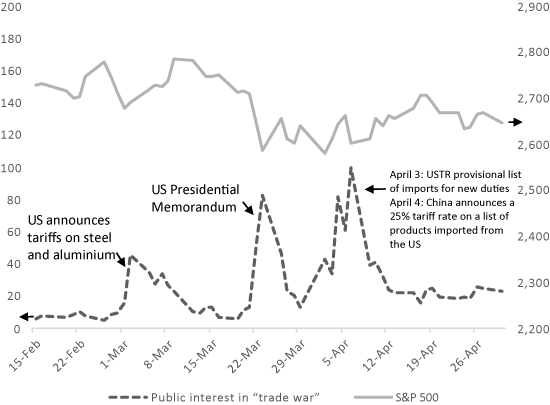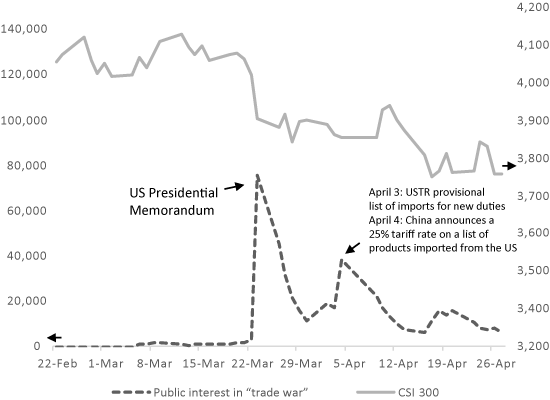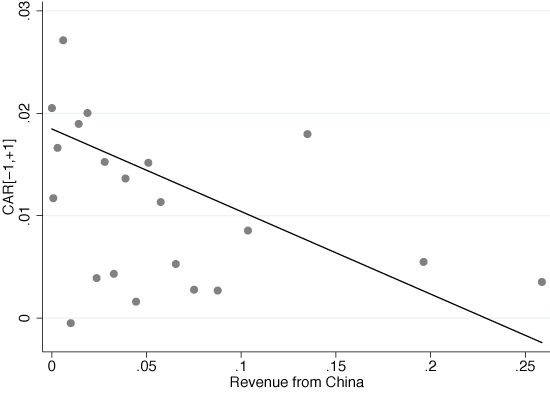Editor’s note: This column first appeared as a chapter in the Vox eBook “Trade War: The Clash of Economic Systems Endangering Global Prosperity”, available to download free here.
On 22 March 2018, the Trump administration started a trade war with China by issuing a presidential memorandum, which proposed to impose 25% tariffs on over $50 billion worth of Chinese imports. On 10 July 2018, it raised the stakes by imposing tariffs of 10% on an additional set of Chinese imports worth $200 billion. Both times, the Chinese government retaliated immediately, imposing tariffs on US imports of similar value. Two recent studies find that US tariffs on China have led to a significant welfare loss (about $7.8 billion, or 0.04% of US GDP) and significant increases in consumer prices in the US, due to an almost complete pass-through of the tariffs to US prices (Amiti et al. 2019, Fajgelbaum et al. 2019).
In a recent study, we evaluate firms’ equity market responses to the various trade war announcements by both the US and Chinese governments in 2018 and 2019 (Huang et al. 2018). We find that within an industry, firms’ reactions to the announcements are heterogeneous, depending on their direct and indirect exposure to US–China trade. More specifically, US publicly listed firms that are more dependent on exports to and imports from China showed lower equity returns but higher default risks in the three-day window around 22 March – the day President Trump signed the first executive memorandum imposing tariffs on Chinese exports. Chinese publicly listed firms that are more reliant on the US as a market for final sales (but not inputs) were also affected significantly more than firms with no direct exposure within the same industry. We also find that firms’ indirect exposure to US–China trade through domestic input-output linkages impacted their responses to the announcement.
These findings suggest that the structure of US–China trade is much more complex than is suggested by the simplistic view that the trade war against China will shift profits from China to the US and only harm Chinese companies that depend on the US markets. Consumers and firms in both countries that are indirectly linked to supply chains involving US and Chinese companies will also be affected. Tariff-induced increases in production costs can be amplified along supply chains until the final stage, when goods are sold to consumers.
Evidence from financial markets based on an event-study approach
As Figure 1 illustrates, the S&P 500 index dropped by 4.5% between 21 March 21 and 23 March 2018 in response to the US presidential memorandum based on the Section 301 Investigation of China’s Laws, Policies, Practices, or Actions. Public interest in the trade war peaked on 22 March, as measured by the frequency of searches for “trade war” on Google. Similar declines in the stock market index and spikes in public interest are also observed for the other two announcement dates (3 and 4 April). These market responses suggest that the US presidential memorandum that initiated the trade war came as a surprise. In China, the US presidential memorandum in March also came as a surprise, bringing down the China Securities Index (CSI) 300 by 4.5% between 22 March and 24 March (Figure 2).
We exploit this unexpected and abrupt policy announcement by the US government on 22 March and apply an event-study approach to examine publicly listed firms’ market responses to the announcement in both countries. We use a novel dataset that reports firms’ intertwining input-output relationships, together with various datasets on companies’ financial outcomes and international trade, to assess a US (Chinese) firm’s direct exposure to imports from and exports to China (the US), as well as US firms’ indirect exposure to trade with China through their engagement in global value chains.
Figure 1 American public interest in the trade war and the Equity Market Index


Note: The solid line indicates the Standard and Poor (S&P) 500 index (right-hand scale), while the dashed line shows public searches for “trade war”, as measured by Google Trends (left-hand scale).
We find significant and heterogeneous responses to the announcement of tariff hikes across listed firms in both countries. In the three-day window surrounding 22 March 2018, US publicly listed companies that export more to (or import more from) China experienced lower stock returns, as illustrated by Figure 3. Specifically, in the three-day window around 22 March, we find that after controlling for standard firm-level characteristics and industry fixed effects, a ten percentage point increase in a firm’s share of sales to China is associated with a 0.5% lower average cumulative abnormal stock return, while firms that directly source inputs from China have a 0.6% lower average cumulative abnormal stock return than those that do not. In addition, firms that are more exposed to US–China trade experienced higher default risks, as revealed by a sudden increase in the implied CDS spread over the same three-day period.
Figure 2 Chinese public interest in the trade war and equity market index


Note: The solid line indicates the China Securities Index (CSI) 300 index (right-hand scale), while the dashed line shows public searches for “trade war”, as measured by Baidu search intensity (left-hand scale).
Our research also exploits the lists of highly disaggregated products that are subject to tariffs imposed by either government. Using natural language processing of 10-K reports filed by US listed firms to the Securities and Exchange Commission (SEC), we measure a company’s share of sales that are subject to the different rounds of tariffs, based on product descriptions. We find that US listed firms that derive proportionally larger sales from products that were subject to the tariffs imposed by the Chinese government on 23 March experienced a larger drop in cumulative equity returns around the announcement date on average. Using US bill of lading data, we can also measure US firms’ dependence on imported inputs from China that were subject to tariffs. We find that the weighted average of a US firm’s import tariffs is negatively correlated with its three-day cumulative stock return around the announcement date.1 These results complement the finding that US tariffs can substantially raise the prices of imported inputs from China, and thus US firms’ costs of production.
Figure 3 US firms’ cumulative abnormal returns and share of sales from China


Note: This figure presents the binned scatter plots for the relationship between a firm’s cumulative abnormal returns adjusted by the market model and its revenue from China.
We find that these negative financial market responses are not the result of overreactions to news. The medium-term (30-day) effects are significantly larger, while the responses of more exposed US firms to subsequent trade war announcements continue to be negative, but weaker. This suggests that the news of a further deteriorating US-China relationship was perceived by the market as less surprising. We also find significantly positive market responses for the exposed firms to the progress made in the US–China trade talks that took place in Beijing between 7 and 9 January 2019. Taken together, these findings suggest that in the absence of real-time economic data, one can use high-frequency financial market data to evaluate the impact of a policy shock on individual firms, and possibly on macroeconomic outcomes.
The effects of the 22 March memorandum on the Chinese financial market were also substantial. Chinese listed firms that are more dependent on sales in the US demonstrated lower stock returns in that three-day window. After controlling for standard firm characteristics and industry fixed effects, a ten percentage point increase in the share of exports to the US in total sales is associated with a 1% larger drop in a firm’s cumulative abnormal stock return in the three-day window surrounding 22 March. However, Chinese firms that import US intermediate inputs did not experience lower stock returns.
Value chains matter
We also find that a firm’s indirect exposure through global value chains matters. We construct production networks that extend up to two levels upstream in the supply chain (i.e. suppliers of a company’s suppliers) of each US listed firm. For example, we find that two important US multinational firms – General Electronic and General Motors – have very dense production networks in the US and that most of the firms’ direct and indirect suppliers have exposure to China through input sourcing.
Using the network data, we gauge individual firms’ equity market reactions to the trade war announcements, due to their direct and indirect exposure to US–China trade through supply chain linkages. On the import side of US listed companies, both direct and indirect exposure to Chinese imports through domestic production networks matter, with the direct exposure to input suppliers in China having a greater quantitative effect. On the export side, both direct and indirect exposure to sales in China matter, but it is the indirect exposure through downstream US firms’ exports to China that has a greater negative impact on firms’ stock returns, compared to the direct sales exposure.
Conclusions
Our research highlights significant financial market losses – in addition to economic losses – in both the US and China due to the trade war in 2018. Our findings for the US reveal adverse effects induced by the perceived increases in the prices of inputs from China due to US tariffs and the perceived reduction in sales in China due to China’s retaliatory tariffs. Our analysis on Chinese listed firms demonstrates that firms’ export exposure – but not their import exposure – determines their responses to the US announcement of tariffs against China.
These firms’ market responses demonstrate that the structure of US–China trade is much more complex than the simplistic view of global trade that prompted Trump’s trade war. Our findings show that the winners and losers in the US–China trade war depend on firms’ positioning in, and exposure to, the global value chains shared by the two countries. While raising the prices of imported goods can transfer profits from foreign to domestic businesses, our study shows that the benefits are far outweighed by the (perceived) increases in input costs. Given the complex structure of US–China trade, most of the firms in both countries were not isolated from such negative cost shocks.
References
Amiti, M, S J Redding and D E Weinstein (2019), “The Impact of the 2018 Trade War on U.S. Prices and Welfare”, CEPR Discussion Paper 13564.
Fajgelbaum, P, P Goldberg, P Kennedy and A Khandelwal (2019), “The Return to Protectionism”, NBER Working Paper 25638.
Huang, Y, C Lin, S Liu and H Tang (2019), “Trade Linkages and Firm Value: Evidence from the 2018 US-China ‘Trade War”, SSRN working paper 3227972.
Endnotes
[1] The weighted averages are constructed based on the US’ 3 April list, with weights equal to import shares in the firm’s total imports.
[Read the original column here.]
Copyright © 2019 VoxEU. All rights reserved.
